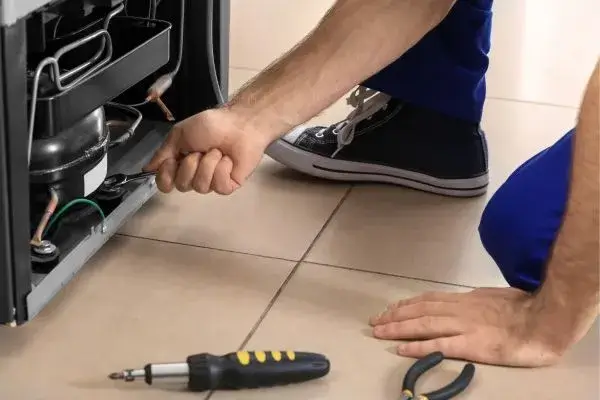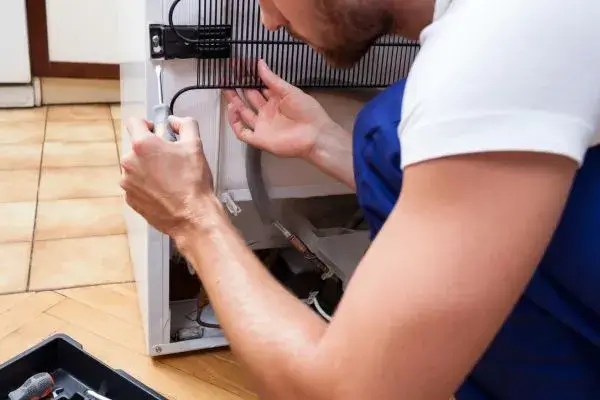Maintaining cool temperatures is essential to preserving food, so the refrigerator compressor is vital. A refrigerator can’t cool appropriately if the compressor fails to start. Knowing how to jump-start a refrigerator compressor can be a valuable skill that saves you time and money.
Jump-starting a refrigerator compressor is easy with these steps: Turn off the fridge, reset temperature settings, wait for stabilization, then press the door switch twice to start the compressor.
To help you diagnose and fix common problems, I’ll also cover safety precautions and troubleshooting tips. You’ll be able to maintain your fridge’s optimal performance by the end of this article.
Why Does the Refrigerator Use a Compressor For Cooling?
When you set your refrigerator’s temperature, the compressor circulates the refrigerant, which absorbs heat from the interior. Think of it as the heart of your refrigerator, responsible for compressing the refrigerant gas and pushing it through the system.
As the gas is compressed, it becomes hot and releases heat into the surroundings. This process transforms the gas into a high-pressure, high-temperature state.
What Are the Reasons for Compressor Failure to Start?
While the compressor is designed to be reliable, certain factors can prevent it from starting up. One common issue is a faulty start relay, a component that initiates the compressor’s operation.
If the relay becomes defective, it won’t send the necessary electrical current to start the compressor.
Another potential culprit is the overload protector, which safeguards the compressor against overheating. If the overload protector malfunctions, it can interrupt the start-up process.

How to Jump Start a Refrigerator Compressor?
Now that you have a solid understanding of the refrigerator compressor and have taken the necessary safety precautions. Following these steps, you won’t have to worry about how to jump-start a refrigerator compressor.

Step 01 – Locate the Compressor and Access Panel
To begin, locate the compressor in your refrigerator. It is usually behind a protective panel at the back, near the bottom. Remove the panel by unscrewing or unclipping it, allowing access to the compressor and its components. Refer to your refrigerator’s manual if you are unsure about the exact location.
Step 02 – Check the Start Relay and Overload Protector
Once you can access the compressor, inspect the start relay and overload protector. These components are often located near the compressor. The start relay sends the electrical current to start the compressor, while the overload protector protects against overheating. Look for any visible signs of damage, such as burnt wires or loose connections.
Step 03 – Use a Multimeter to Test the Components
To determine if the start relay or overload protector is faulty, you can use a multimeter, a handy tool for measuring electrical currents. Set the multimeter to the resistance (ohms) mode and test the continuity of the components. If the multimeter readings indicate an open circuit or infinite resistance, it may indicate a defective part that needs replacement.
Read More about: How to use a multimeter?
Step 04 – Disconnect Power and Discharge the Capacitor (if applicable)
Before proceeding further, disconnect the power supply to the refrigerator and ensure no electrical current is flowing. If your refrigerator has a capacitor, it’s essential to discharge it to prevent any potential electrical shocks. Follow the manufacturer’s instructions or consult a professional to discharge the capacitor safely.
Step 05 – Use a Jumper Wire to Bypass the Start Relay
If you have determined that the start relay is the cause of the compressor’s failure to start, you can attempt to bypass it temporarily using a jumper wire. Locate the terminals on the start relay and carefully attach the jumper wire between the “common” and “run” terminals. This bypasses the start relay, allowing the electrical current to flow directly to the compressor.
Step 06 – Reconnect Power and Listen for Compressor Operation
With the jumper wire in place, reconnect the power supply or turn on the circuit breaker to provide electricity to the refrigerator. Listen closely for any sounds indicating that the compressor has started running. The compressor may take a few seconds to kick in and start operating.
Step 07 – Monitor the Compressor
Observe the compressor’s operation for a few minutes to ensure it continues running smoothly without unusual noises or irregularities. Pay attention to overheating or excessive vibrations, which may indicate underlying issues requiring professional attention.
Step 08 – Replace Faulty Components
If the compressor starts successfully and operates without problems, the start relay or overload protector is likely causing the starting issue. Replacing the faulty component(s) with new ones compatible with your refrigerator model is advisable. However, if the compressor still fails to start or exhibits concerning behavior, it’s best to seek assistance from a qualified appliance technician.

Troubleshooting precautions
Some potential causes include a malfunctioning start relay, a faulty overload protector, damaged wiring, or a more complex electrical or mechanical issue. Some common problems are given below:
1. The Compressor Still Doesn’t Start
If you’ve followed the jump-starting procedure, but the compressor still fails to start, other underlying issues could be at play. First, double-check all connections to ensure they are secure and properly attached. Inspect the wiring for any signs of damage, such as frayed wires or loose connections. If everything appears in order, it’s advisable to consult a professional technician who can diagnose and repair more complex electrical or mechanical problems.
2. Unusual Noises
How to jump-start a refrigerator compressor is very easy. Still, during the compressor jump-start, if you notice unusual noises or excessive vibrations, it may indicate a separate issue that requires attention. Check for loose components or connections, ensuring everything is tightly secured.
Excessive vibrations can sometimes be caused by an unbalanced compressor, which may require professional adjustment or repair. Consulting an expert is recommended if you need clarification on the source of the noise or vibrations.
3. Overheating Issues
If the compressor becomes excessively hot during or after the jump-starting process, it’s crucial to address this issue promptly. Various factors, such as a malfunctioning overload protector or inadequate ventilation around the compressor, can cause overheating.
Read more about: How to test Thermal Fuse with multimeter?
Ensure the overload protector is functioning correctly and not tripping due to overheating. Additionally, check for obstructions or blockages that may restrict airflow around the compressor. Regular cleaning of the refrigerator coils and proper ventilation can help prevent overheating issues.
4. Seeking Professional Assistance
While jump-starting a refrigerator compressor can resolve many starting issues, it’s important to recognize when professional assistance is necessary. If you’re uncomfortable or uncertain about the jump-starting process or if troubleshooting efforts do not yield satisfactory results, it’s best to contact a qualified appliance technician.
They have the expertise and specialized tools to diagnose and repair complex problems, ensuring the optimal functioning of your refrigerator.
Safety Tips
Taking the necessary Tips protects you and ensures you properly handle electrical components. The following tips will help you stay safe:
1. Unplug the Refrigerator and Disconnect Power
Safety should always come first, so start by unplugging your refrigerator from the power source. This step prevents any electrical shocks or accidents while working on the compressor.
Additionally, it’s recommended to disconnect the power supply or turn off the circuit breaker that controls the refrigerator’s electrical circuit. Double-check that there is no power flowing to the appliance before proceeding.
2. Wear Protective Gear
The correct protective gear is essential when dealing with electrical and mechanical components. Equip yourself with a pair of insulated gloves to protect against electrical shocks.
Safety glasses or goggles should also be worn to shield your eyes from debris or possible splashes. By wearing these simple protective measures, you can minimize the risk of injury and work confidently.
3. Avoid Tampering with Electrical Components
While troubleshooting or jump-starting the compressor, it’s important to remember that you’re dealing with electrical components. Only tampering with the electrical system or attempting repairs beyond your comfort level if you have the necessary expertise.
Manipulating wiring or circuits without proper knowledge can lead to further damage or even pose a safety hazard. If you need more clarification on any electrical aspect, it’s best to seek assistance from a qualified professional.
How Do I Maintain My Refrigerator Compressor?
Now that you know how to jump-start a refrigerator compressor, it’s time to consider maintenance. Proper maintenance ensures your refrigerator compressor’s long-term health and optimal performance.
By implementing regular care and preventive measures, you can extend the compressor’s lifespan and minimize the chances of encountering starting issues. Explore some essential maintenance tips to keep your compressor in excellent condition.
1. Regular Cleaning and Dust Removal
Dust and debris can accumulate on the refrigerator coils, affecting the compressor’s efficiency. Regularly clean the coils by gently vacuuming or using a soft brush to remove any built-up dirt.
This simple maintenance task improves airflow and prevents the compressor from overworking, ultimately extending its lifespan.
2. Maintain Proper Temperature and Airflow
Maintaining a consistent temperature and proper airflow around the refrigerator is vital for the compressor’s health. Avoid placing the refrigerator near heat sources like ovens or direct sunlight, as excessive heat can strain the compressor.
Ensure adequate space around the refrigerator for proper ventilation, allowing air to circulate freely and keep the compressor cool.
3. Regular Inspections and Tune-ups
Periodically inspect your refrigerator for any signs of wear or potential issues. Check for loose connections, damaged wiring, or worn-out components. If you notice any problems, address them promptly to prevent further damage.
Consider scheduling regular tune-ups with a professional technician to ensure your refrigerator and compressor receive comprehensive maintenance and necessary repairs.
4. Avoid Overloading and Uneven Weight Distribution
Overloading the refrigerator with excessive items or unevenly distributing the weight can strain the compressor. Be mindful of the recommended maximum capacity for your refrigerator model and distribute the contents evenly.
This practice prevents unnecessary strain on the compressor, promoting its longevity and optimal functioning.
Conclusion
Don’t worry about how to jump-start a refrigerator compressor. Getting your refrigerator compressor up and running can be as easy as jump-starting it. Remember to unplug the fridge and find the start relay near the compressor. Check for loose parts by gently removing the start relay. Replace the start relay if you suspect it’s faulty. The compressor can also be kicked off with a hard start kit.
Make sure the equipment works with your fridge. Cleaning the condenser coils and checking for blockages can also help. It’s also recommended to seek professional assistance if all else fails. Your refrigerator’s compressor can be revived with these steps, saving you time and money. Happy troubleshooting, and keep the fridge cold!
Frequently Asked Questions
Can you restart a fridge compressor?
Yes, it is possible to restart a fridge compressor. You can try unplugging the refrigerator for a few minutes and then plugging it back in. If the compressor was in a temporary overload state, this may reset it. However, if there is a more serious issue with the compressor or the refrigerator’s electrical system, a professional technician should be contacted.
What causes a refrigerator compressor not to start?
Several factors can cause a refrigerator compressor not to start. Common causes include a faulty start relay or capacitor, a defective thermostat, or electrical issues such as a tripped circuit breaker or a damaged power cord. Additionally, low refrigerant levels or a seized compressor can also prevent the compressor from starting.
What starts a fridge compressor?
The fridge compressor is typically started by the refrigerator’s thermostat. When the temperature inside the refrigerator rises above the set point, the thermostat signals the compressor to turn on and start cooling. The compressor motor then engages and begins compressing the refrigerant, initiating the cooling process.
How do you bypass a refrigerator compressor?
Bypassing a refrigerator compressor is not recommended and should only be attempted by qualified professionals. However, if you need to temporarily bypass the compressor for troubleshooting purposes, you would typically disconnect the compressor from the electrical circuit. At the same time, ensures the rest of the refrigerator’s components remain connected and functional. It’s crucial to consult an expert technician to ensure proper safety precautions and prevent damage to the appliance.

